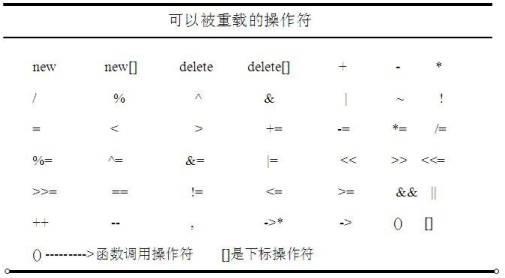参考:轻松搞定c++语言
定义:赋予已有运算符多重含义,实现一名多用(比较函数重载)
运算符重载的本质是函数重载
重载函数的格式:
函数类型 operator 运算符名称(形参表列) {
重载实体;
}
比如:
const Complex operator+(const Complex &c1,const Complex &c2);
友元函数的重载:

1 #include <iostream> 2 using namespace std; 3 4 class Complex 5 { 6 public: 7 Complex(float x=0, float y=0) :_x(x),_y(y){} 8 void dis() 9 { 10 cout<<"("<<_x<<","<<_y<<")"<<endl; 11 } 12 friend const Complex operator+(const Complex &c1,const Complex &c2); 13 private: 14 float _x; 15 float _y; 16 }; 17 const Complex operator+(const Complex &c1,const Complex &c2) 18 { 19 return Complex(c1._x + c2._x,c1._y + c2._y); 20 } 21 int main() 22 { 23 Complex c1(2,3); 24 Complex c2(3,4); 25 80 26 27 c1.dis(); 28 c2.dis(); 29 Complex c3 = c1+c2; 30 //Complex c3 = operator+(c1,c2); 31 c3.dis(); 32 return 0; 33 }
成员重载:

1 #include <iostream> 2 3 using namespace std; 4 5 class Complex 6 { 7 public: 8 Complex(float x=0, float y=0) :_x(x),_y(y){} 9 void dis() { 10 cout<<"("<<_x<<","<<_y<<")"<<endl; 11 } 12 friend const Complex operator+(const Complex &c1,const Complex &c2); 13 const Complex operator+(const Complex &another); 14 private: 15 float _x; 16 float _y; 17 }; 18 const Complex operator+(const Complex &c1,const Complex &c2) 19 { 20 cout<<"友元函数重载"<<endl; 21 return Complex(c1._x + c2._x,c1._y + c2._y); 22 } 23 const Complex Complex::operator+(const Complex & another) 24 { 25 cout<<"成员函数重载"<<endl; 26 return Complex(this-‐>_x + another._x,this-‐>_y + another._y); 27 } 28 int main() 29 { 30 Complex c1(2,3); 31 Complex c2(3,4); 32 c1.dis(); 33 c2.dis(); 34 81 35 36 //Complex c3 = c1+c2; 37 //Complex c3 = operator+(c1,c2); 38 Complex c3 = c1+c2; 39 c3.dis(); 40 return 0; 41 }
重载规则:
(1) C++不允许用户自己定义新的运算符,只能对已有的 C++运算符进行重载。

4个不可以重载的运算符:
- . (成员访问运算符)
- .*(成员指针访问运算符)
- ::(域运算符)
- sizeof(长度运算符)
- ?:(条件运算符)
(2)重载不能改变运算符运算对象(即操作数)的个数,双目运算符重载后也是双目运算符)
(3)重载不能改变运算符的优先级别。
(4)重载不能改变运算符的结合性。
如,复制运算符” =“是右结合性(自右至左),重载后仍为右结合性。
(5)重载运算符的函数不可以有默认参数
(6)重载的运算符必须和用户定义的自定义类型的对象一起使用,其参数至少应有
一 个是类对象(或类对象的引用)。
(7)用于类对象的运算符一般必须重载,但有两个例外,运算符” =“和运算
符” &“不 必用户重载。
- 复制运算符” =“可以用于每一个类对象,可以用它在同类对象之间相互赋值,因为系统已为每一个新声明的类重载了一个赋值运算符,它的作用是逐个复制类中的数据成员。地址运算符&也不必重载,它能返回类对象在内存中的起始地址。
(8)运算符重载函数可以是类的成员函数,也可以是类的友元函数,还可以是既非
类 的成员函数也不是友元函数的普通函数
单目运算符:(只需要一个操作符)sizeof +(正) -(负) ! ++ -- ~(位非)
双目运算符:+, -, *, /, %, <, >, >=, <=, ==, !=, <<, >>, &, ^, |, &&, ||, =
//使#用: L#R operator#(L,R); //全局函数 L.operator#(R); //成员函数
operator+=:

1 //作为友元函数 2 class A 3 { 4 int a,b; 5 public: 6 A(int x, int y) : a(x), b(y) {} 7 friend A operator + (const A&, const A&); 8 }; 9 A operator + (const A& x, const A& y) 10 { 11 int a = x.a + y.a; 12 int b = x.b + y.b; 13 return A(a,b); 14 } 15 16 //作为成员函数 17 class A 18 { 19 int a,b; 20 public: 21 A(int x, int y) : a(x), b(y) {} 22 A operator + (const A&); 23 }; 24 A A::operator + (const A& x) 25 { 26 return A(a+x.a, 27 b+x.b); 28 }
